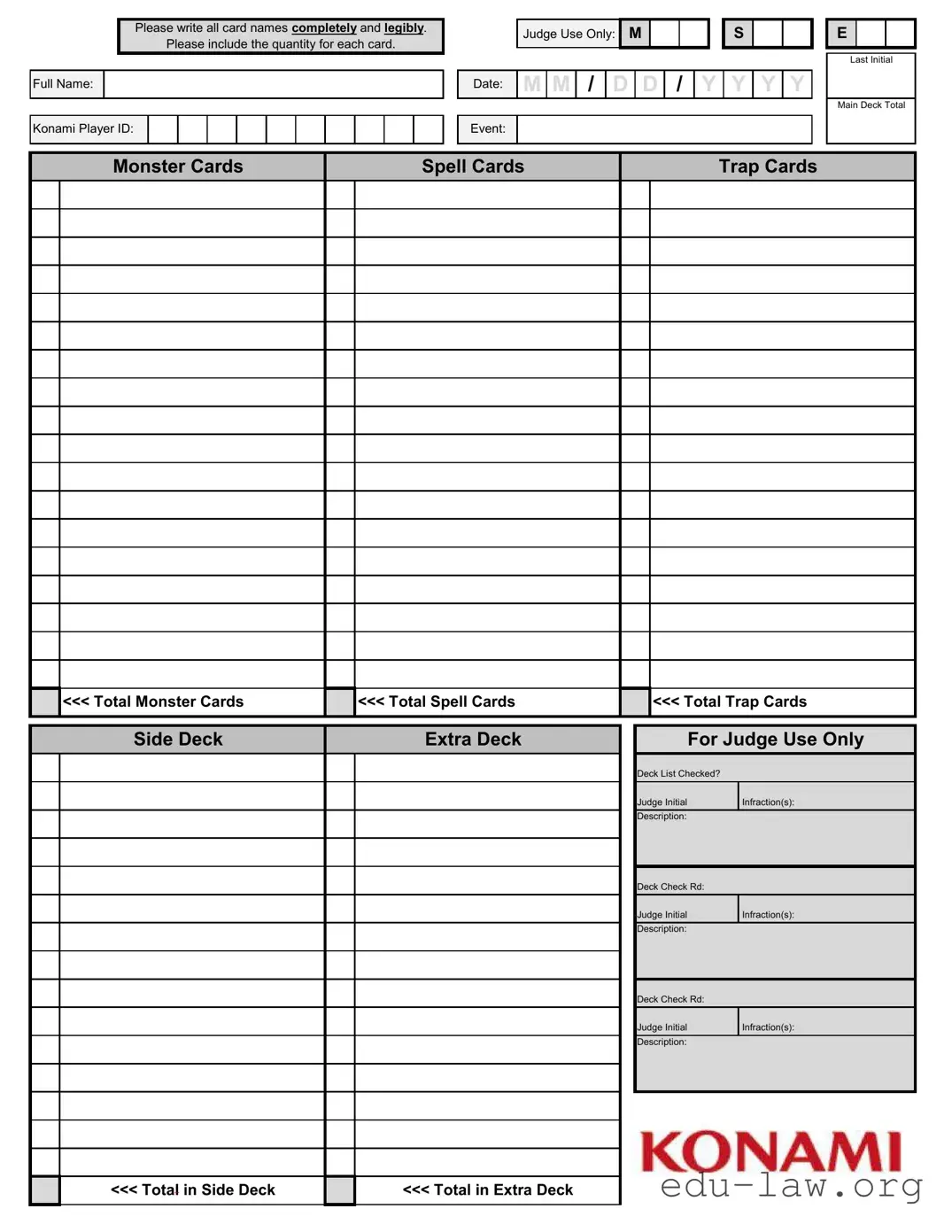The Konami Decklist form shares similarities with the Standard Tournament Registration form used in various competitive events. Both require participants to fill out personal information, including full name and identification. Additionally, they ensure transparency by mandating the accurate listing of items or cards. Just as the Tournament Registration form focuses on event specifics and player identification, the Decklist form emphasizes the player's deck composition, detailing the quantities of various card types.
Another document similar to the Konami Decklist is the Magic: The Gathering Decklist. Like the Konami form, it asks players to list their card names and quantities clearly. Both documents allow judges to check the legality and adherence to tournament rules. The Magic Decklist includes sections for main decks, sideboards, and extra cards—mirroring how the Konami form organizes monster, spell, and trap cards into distinct categories.
The Player Agreement is also akin to the Konami Decklist but serves a different purpose. It outlines the rules and expectations for players participating in a tournament. While the Decklist focuses on card composition, the Player Agreement emphasizes sportsmanship and compliance with tournament guidelines. Both documents require clear, legible writing for identification and validation, ensuring each player's adherence to the established standards.
The Event Report form, used by judges and tournament organizers, bears resemblance to the Konami Decklist in its structure. It often requires detailed notes about specific incidents during the tournament, similar to the infractions section in the Decklist. Both documents record essential information for accountability, helping maintain the integrity of the event while ensuring a fair playing environment.
The Registration Check form used in sports tournaments is another document that aligns with the Konami Decklist. Both require personal details from participants and a way to confirm eligibility to compete. The similarities extend to the necessity for accurate and complete information, which is crucial for event organizers and judges to monitor and manage participants effectively.
The Score Sheet in gaming tournaments resembles the Konami Decklist because both assess the participant's performance. Each document requires clarity and completeness, whether it involves listing all card names or logging match results. Accuracy is vital in both contexts, ensuring fair competition and proper tracking of events.
The Roster Submission document in team sports functions similarly to the Konami Decklist. Each player must be listed with specific identifiers, such as names and numbers. Like the Decklist, the Roster Submission ensures that all participants are accounted for, allowing organizers to keep track of who is eligible to compete and in what capacity.
The Equipment Check form used in various competitions bears likeness to the Konami Decklist. Both documents involve a detailed inspection process where specific items must be listed and verified for compliance. Clarity and accuracy in both forms help ensure the equipment meets the necessary standards for fair competition.
The Checklist used by judges at tournaments also has striking similarities with the Konami Decklist. Both serve as a way for officials to verify that players are adhering to rules and regulations. This document enables judges to record any issues or infractions, helping maintain the smooth operation of the event, just as the Decklist facilitates communication between players and judges regarding deck legality.
Finally, the Game Log used in various card games shares some parallels with the Konami Decklist. While the primary function of the Game Log is to document moves made during play, it also includes player identification details. Both the Game Log and the Decklist help maintain order and transparency in competitive settings, highlighting the importance of clear communication and documentation in all aspects of tournament play.




 <<< Total Monster Cards
<<< Total Monster Cards <<< Total Spell Cards
<<< Total Spell Cards <<< Total Trap Cards
<<< Total Trap Cards